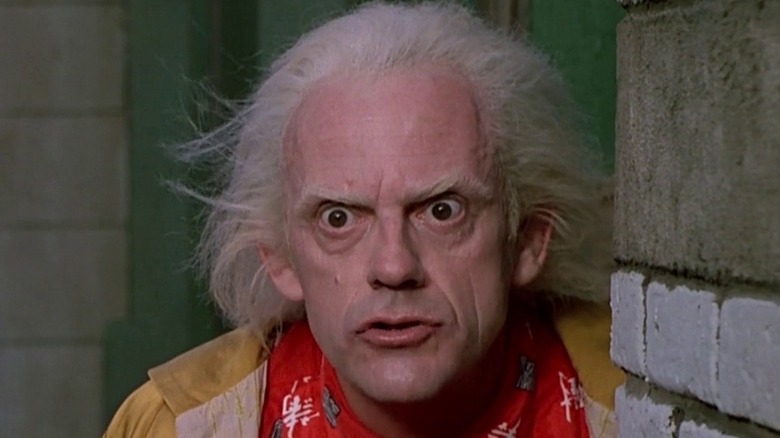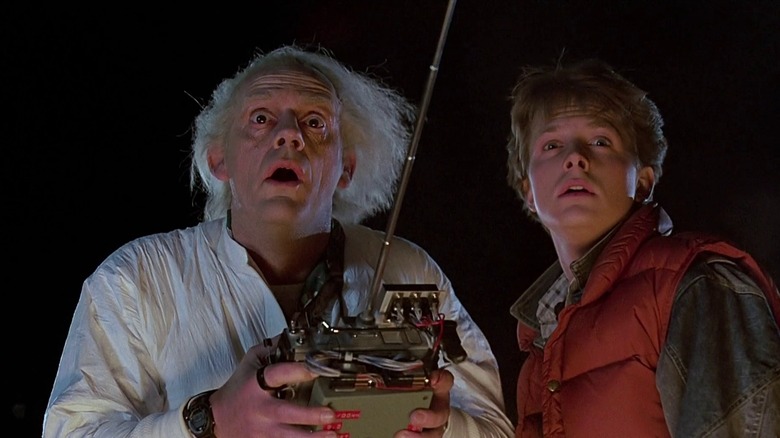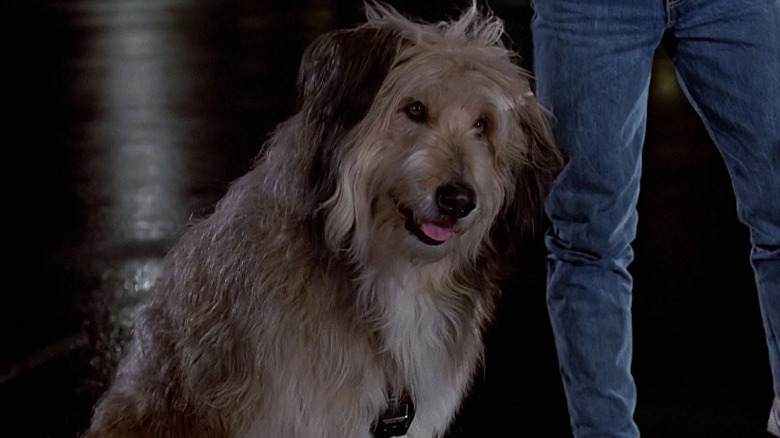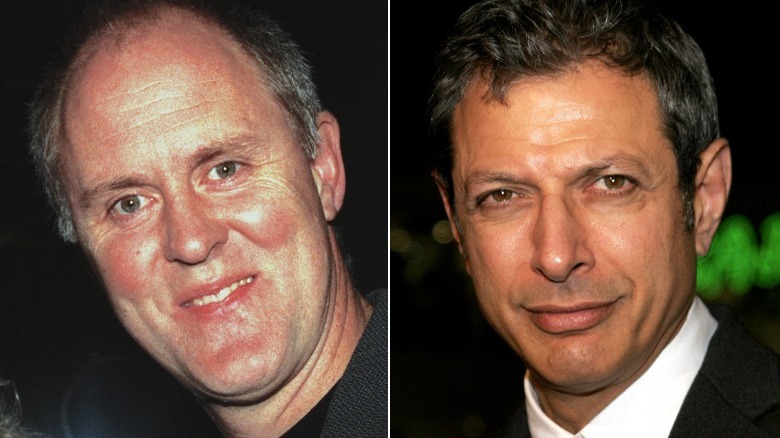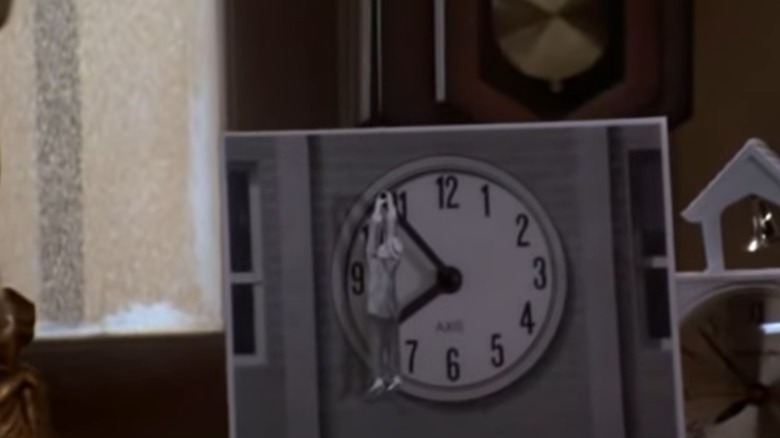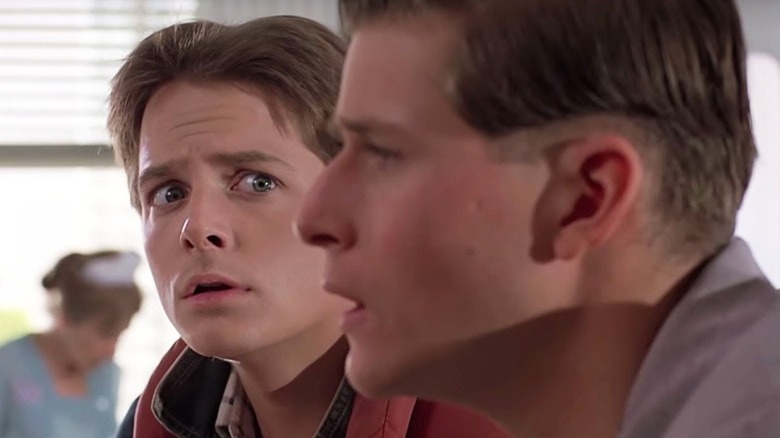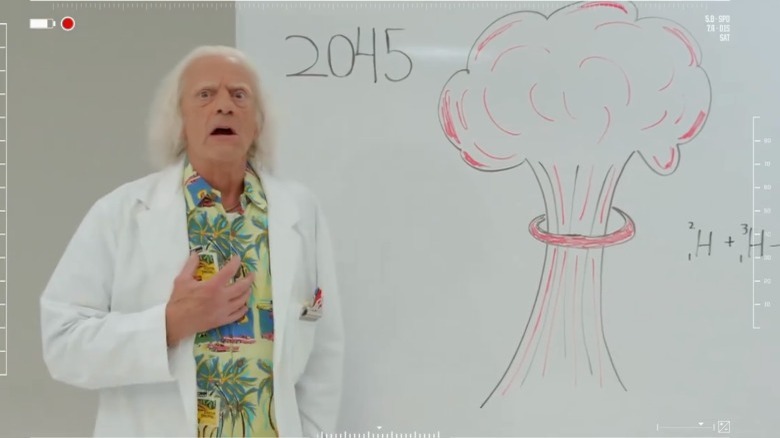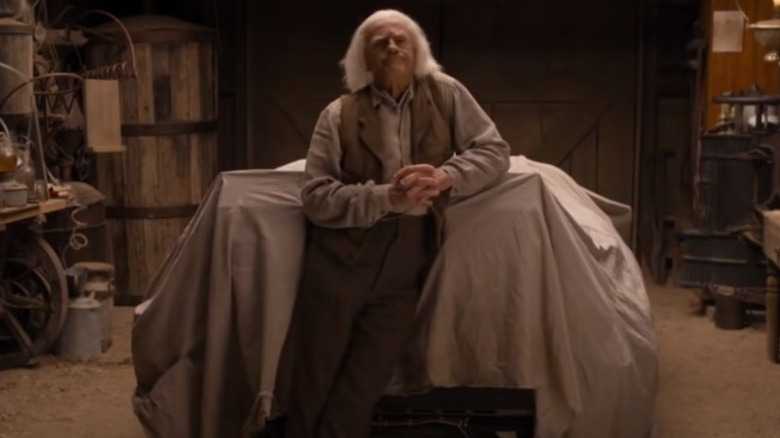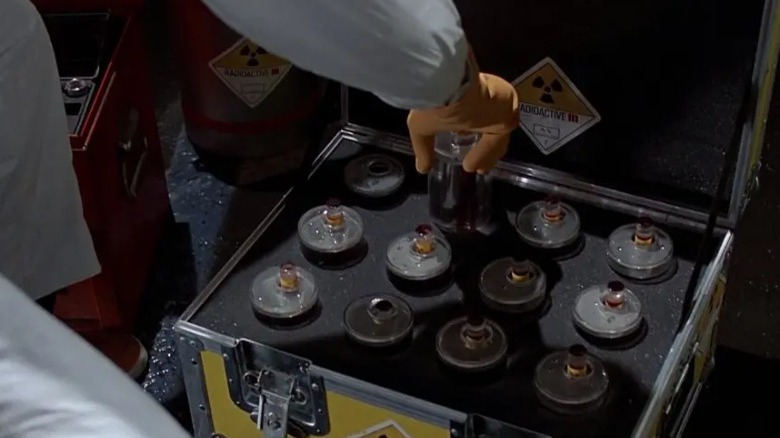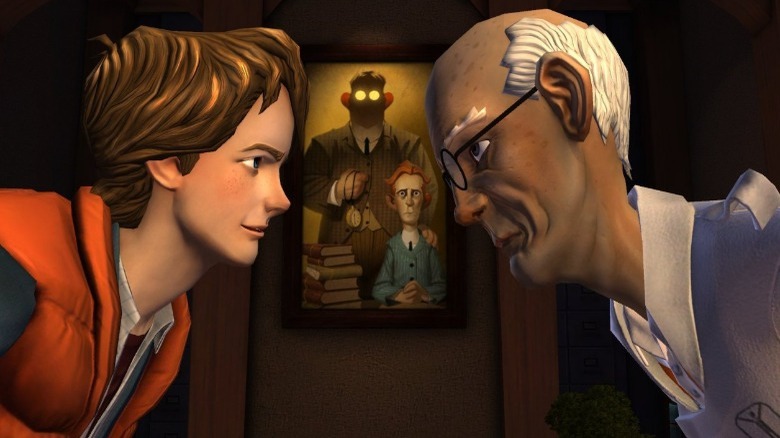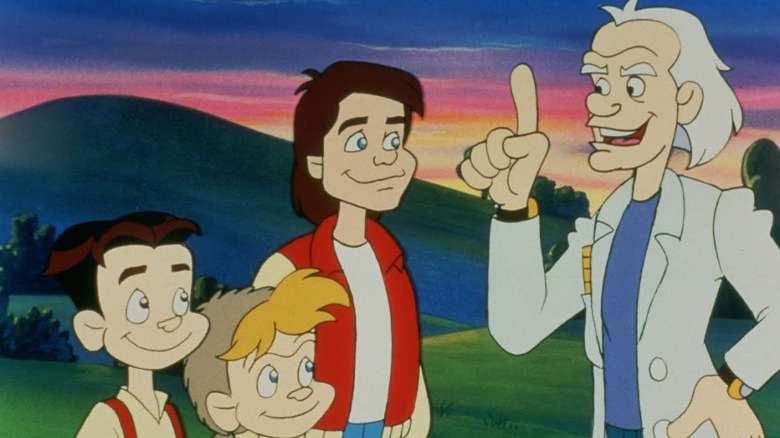The Untold Truth Of Doc Brown
Great Scott! Two simple words instantly elicit memories of one of pop culture's greatest sci-fi heroes, Doctor Emmett Brown (Christopher Lloyd). Much like an eccentric cartoon character, the white-haired brainiac is somehow simultaneously brilliant and childishly naïve. Sure, he may be the first to discover time-travel, but he somehow managed to steal a volatile and illegal substance like plutonium from terrorists and not anticipate repercussions.
Most see Marty's mentor and comrade as head case. Marty is the only one who ever truly appreciated Doc's genius and, as such, he got to know the man behind the white lab coat. Doc Brown is perpetually an optimist always seizing an opportunity for hope amid dark times and circumstances. He's continually fascinated by the world around him, which ultimately makes him an effective scientist and inventor.
"Back to the Future" is a far bigger franchise than most folks realize. It didn't stop at just three films. Official short films, an animated series, and even video games all helped add to the universe created by Bob Gale and Robert Zemeckis. With a notably vibrant character at the helm of the franchise, it's no surprise that there are plenty of details and lore behind the colorful Doc Brown. Let's dive into some of the least known facts about the inventor.
How Doc Brown and Marty met
The "Back to the Future" trilogy of films establishes a boisterous, happy-go-lucky scientist and an edgy (for the time), hip teenager in an odd yet compelling pairing. While Doc Brown and Marty McFly (Michael J. Fox) don't exactly seem like folks that would "mix" and become fast friends, they actually have quite an engaging chemistry on-screen.
So the question then becomes, how did these two actually meet? The first film already begins with Marty and Doc having been well-acquainted.
Mental Floss actually reached out to co-writer and co-creator of the franchise, Bob Gale, for an answer to this question. Gale responded and acknowledged that he and Robert Zemeckis never actually addressed the initial meeting between the two characters, but they did work out the history. Gale claims that Doc was an infamous character around town. He was often seen as crazy, so most folks avoided him. As a young teen, Marty's curiosity got the better of him and he snuck into Doc's lab one day to see what all the fuss was about. Ultimately, Marty was intrigued by Doc's work and his experiments. When Doc Brown actually caught the teen in his lab, he was taken back by how "cool" Marty perceived him to be. So, he offered Marty some work helping with experiments and looking after his dog, Einstein. And, as they say, the rest is history.
Doc Brown originally owned a chimp instead of a dog
Fans of the film series are well-acquainted with Einstein, Doc Brown's loveable canine companion. Despite being a loyal and beloved pooch, he still used the animal as a test subject for Doc's time travel experiment. Thankfully, Einstein returned, proving to be the first living creature in history to time travel.
However, Einstein wasn't always meant to be. In fact, Doc Brown's animal assistant was originally destined to be a chimp by the name of Shemp. Bob Gale revealed this fact in Netflix's docuseries "The Movies That Made Us." However, the entertainment executive at Universal overseeing the project, Sid Sheinberg, told the filmmakers that movies with chimps don't make any money. When Bob Gale questioned Sheinberg by asking about the successful Clint Eastwood film "Every Which Way But Loose," Sheinberg pointedly replied that the primate in those films was an orangutan. Ultimately, he asked for the chimp to be cut from the film, which prompted Zemeckis and Gale to replace him with a dog.
According to the same episode of the Netflix docuseries, a screen test of the film shocked audiences after Einstein was used to test the DeLorean. For a split second, audiences were horrified thinking Doc just killed the dog, and were audibly elated when Einstein made a quick return. Perhaps changing the animal to a lovable dog made all the difference.
John Lithgow and Jeff Goldblum were considered for the role
Christopher Lloyd defined the role of Doc Brown. It's rather difficult to imagine any other actor in the role of the quirky scientist. However, according to Vulture, John Lithgow was once considered to portray Doc Brown. With recent films like "Terms of Endearment" and "Footloose" to his name, Lithgow had become a bankable actor in Hollywood by the time pre-production for "Back to the Future" was in full swing.
Vulture also notes that Jeff Goldblum actually auditioned for the part. Goldblum eventually ended up playing a number of sci-fi roles, including the "The Fly" and "Jurassic Park." However, he was ultimately too young for the role of the good doctor, and was passed over in favor of Christopher Lloyd. Interestingly, Christopher Lloyd, John Lithgow, and Jeff Goldblum all starred in the 1984 film "The Adventures of Buckaroo Banzai Across the 8th Dimension" just prior to "Back to the Future."
A clock in Doc Brown's office foreshadows the film's ending
"Back to the Future" has been analyzed by countless fans and critics over the years. There are plenty of fan theories and speculation regarding the series and the multiple time jumps that occur throughout. But there are also plenty of details that were included by the filmmakers to tie the themes of the story together.
In the opening moments of the film, we're treated to a nice view of Doc Brown's cluttered workspace. Scattered about are countless clocks -– a scene immediately on the nose for the film's theme of time travel. As the camera pans across a desk, one clock in particular is a bit peculiar. It depicts a man hanging onto the minute hand for dear life. This acts as a cheeky bit of foreshadowing, given that the end of the film sees the 1955 version of Doc Brown hanging off of the Hill Valley clock tower as part of an elaborate plan to help Marty go back to the future. Perhaps the 1985 version of Doc Brown at the beginning of the film already understood that this event occurred, and the clock was simply an icon reminding him of a major moment that occurred 30 years prior.
Doc Brown, by proxy, might have changed George McFly's path
Ultimately, the entire plot of the "Back to the Future" trilogy is Doc Brown's doing: Without Doc Brown, there'd be no time machine. There's also an argument that, without Doc Brown, Marty might not have had the traits to change his father's life.
The film presents Marty amid a troubled family life. While we don't expressly see any dire circumstances in Marty's home life, it's clear that his parents are rather cold and distant. George McFly isn't encouraging by any stretch and is hardly what you'd call an honest-to-goodness father figure. He lets Biff walk all over him and tells Marty that his social aspirations would just be a "headache" after Marty is upset over the car. When Lorraine, Marty's mother, recounts how she met George she almost has a somber tone in her voice, signaling her unhappiness in the marriage. Meanwhile, George disregards it all and just laughs at the antics occurring on the TV.
Doc Brown took an abiding interest in Marty. He genuinely cared for the teen and acted as a mentor. After continually failing in his experimentations, he continued to persist without ever caring what the townsfolk of Hill Valley thought of him. He is the example of a true go-getter, the very upstanding figure Marty could look up to. It was these life lessons that Marty actually put to use when coaching George McFly to ask Lorraine to the dance. Marty's persistence was truthfully a quality instilled in him by Doc Brown. Therefore, it was really Doc Brown's mentorship that ultimately helped change George McFly's life for the better.
Doc Brown saved the world from nuclear holocaust
Three decades after the release of "Back to the Future," a 30th anniversary Blu-ray collection of the trilogy was released with a new short entitled "Doc Brown Saves the World." The film takes place in a lab setting, where Doc records a message to Marty in the year 2015, detailing how multiple inventions lead to the destruction of humanity in 2045. The food hydrator creates an excess of food, causing widespread obesity. This leads to shoe stores only selling slippers or self-lacing shoes, because a majority of the population can't even bend down to tie their shoes. With laziness settling over society, consumers opt for the hoverboard over walking. The spike in interest over the technology leads to hovercars. Flying above the city makes it far easier for drivers to litter, which results in a trash crisis. This leads to the creation of the Mr. Fusion Home Energy Reactor, which is powered by nuclear cold fusion and converts waste into energy.
Griff Tannen creates a social media network, which uses to troll the entire world. He uploads a virus using the Mr. Fusion network, which is only supposed to display the word "Butthead" on every device. However, it causes the self-destruction of 100 million fusion reactors ending the world. Doc then jumps in the DeLorean and travels through time to prevent these inventions from existing. The camera stays fixated on the inventions in his lab, which disappear one-by-one. Once Doc Brown returns, he celebrates ... before realizing he took a piece of tech with him that belongs in 2075. Just then, another Doc Brown appears and the two are startled to be encountering each other.
Well, the paradox didn't cause the world to cease to exist like Doc postulated. So, there's that!
Doc Brown appears in A Million Ways to Die in the West
"Back to the Future" has inspired other filmmakers and storytellers. Many continue to honor the film series through cameos or Easter eggs. One such cameo occurs in the comedy film by Seth McFarlane "A Million Ways to Die in the West."
In the film, Albert (Seth McFarlane) notices a strange blue light emanating from a barn and investigates. After peering in, he sees Doc Brown working on the DeLorean. Quickly, Doc covers up the machine. When Albert asks him what that machine is, Doc quips that it's a "weather experiment." Albert then walks away as Doc Brown exclaims his famous one-liner, "great Scott!"
It may just be a fun reference to the series, but Doc Brown did travel to the Old West after all. Though, "A Million Ways to Die in the West" takes place in 1882 — just three years prior to the actual year that Doc traveled to in "Back to the Future Part III." Who knows, though? Perhaps he took a quick detour with his scrambled journey.
Doc Brown has no trouble committing criminal acts for his experiments
So, let's get it all out on front street. Doc Brown is a felon. In fact, it may be far worse. He brokered an exchange of nuclear materials (plutonium) in exchange for bomb construction for Libyan terrorists. Now, of course, he never actually built a bomb, remarking that he provided them a contraption filled with pinball machine parts. However, he still colluded with a rogue extremist outfit and received a highly illegal and fissile material in exchange. While this story element is expressly depicted in the beginning act of the first film, the light-hearted tone of the film doesn't emphasize the gravity of the criminal act aside from the repercussions of ripping off terrorists.
This doesn't make Doc Brown a bad guy by any stretch. He at least had the moral gumption needed to not actually build a bomb. It's just a demonstration of how determined and single-minded his approach is to his decades-long journey in realizing a true-blue time machine. Nothing will stop him.
Doc Brown once became a tyrant known as Citizen Brown in 1931
It's no surprise that "Back to the Future" extended to other mediums, including books and even video games. In 2010, Telltale Games released a narrative episodic video game adventure that takes place after the original trilogy of films. The game finds Marty and Doc Brown traveling to 1931. Marty travels there after finding out that Doc went back and was killed by Irving "Kid" Tannen. As usual, he attempts to correct that mistake, but only causes further problems in the timeline. Eventually, the young Emmett Brown of the past ends up falling in love with Edna Strickland, a callous woman and relative of Mr. Strickland from Marty's school.
The new 1986 depicts a Hill Valley that is living in a totalitarian state. Instead of Doc Brown, he is known as Citizen Brown and has been corrupted by Edna to enforce social order on the citizens of the Hill Valley. Essentially, he's introduced a police state and many of the town's residents fear speaking up. While this seems completely contrary to everything we know about the brilliant scientist, a few decades under the thumb of one manipulative person can certainly change an individual. Marty attempts to prove to Citizen Brown that he is truly a time traveler and once had very different dreams and ambitions in an effort to correct the timeline. If video games aren't your style, IDW adapted the storyline in a limited series of comics titled "Back to the Future: Citizen Brown."
Doc takes his sons on time-traveling adventures
We all know how Doc Brown's life shaped up. He met the love of his life Clara back in the Old West and created an entirely new time-traveling machine to embark on new adventures (as we see with the episodic video game). He even had two sons, who he named Jules and Verne — obvious historical references.
However, in 1991, an animated series — also titled "Back To the Future" — debuted, in which Doc Brown moved his family to a farm in the present Hill Valley. Marty could once again head off on adventures with his inventor pal. However, Doc would often take his two boys to eras like the Middle Ages or prehistoric times. Time-traveling became a bit of a family affair, and the episodic nature of the series allowed the characters to explore many different destinations. While Marty was a part of the series, it largely explored the dynamic of Doc Brown's family life. Unfortunately, the series only lasted two seasons. However, fans should note that the franchise co-creator Bob Gale executive produced the series, giving it a sense of authenticity.
